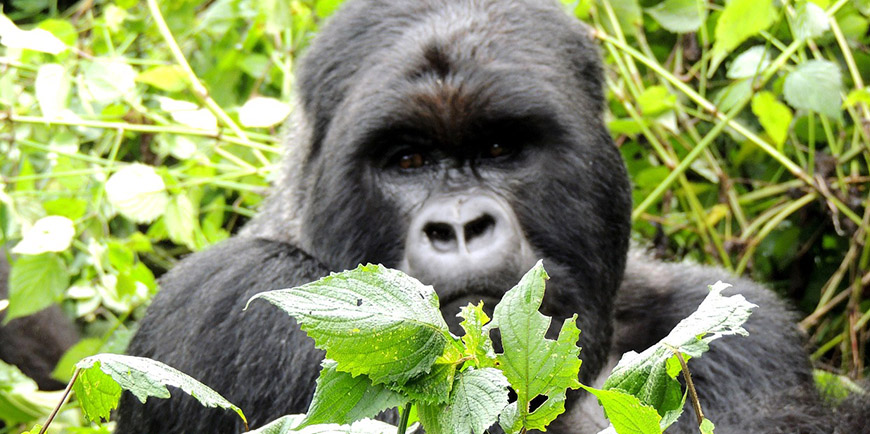
The mountain gorilla (Gorilla beringei beringei) is one of the two subspecies of the eastern gorilla. There are two populations. One is found in the Virunga volcanic mountains of Central Africa, within three National Parks: Mgahinga, in south-west Uganda; Volcanoes, in north-west Rwanda; and Virunga in the eastern Democratic Republic of Congo (DRC). It is listed as critically endangered by the IUCN. The other is found in Uganda’s Bwindi Impenetrable National Park. As of September 2015, the estimated number of gorillas remaining is less than 900.
The mountain gorilla is highly social, and lives in relatively stable, cohesive gorilla groups held together by long-term bonds between adult males and females. Relationships among females are relatively weak. These groups are nonterritorial; the silverback generally defends his group rather than his territory. In the Virunga mountain gorillas, the average length of tenure for a dominant silverback is 4.7 years.
61% of gorilla groups are composed of one adult male and a number of females and 36% contain more than one adult male. The remaining gorillas are either lone males or exclusively male gorilla groups, usually made up of one mature male and a few younger males. Gorilla Group sizes vary from five to thirty, with an average of ten individuals. A typical group contains: one dominant silverback, who is the gorilla group’s undisputed leader; another subordinate silverback (usually a younger brother, half-brother, or even an adult son of the dominant silverback); one or two blackbacks, who act as sentries; three to four sexually mature females, who are ordinarily bonded to the dominant silverback for life; and from three to six juveniles and infants.
The dominant silverback generally determines the movements of the gorilla group, leading it to appropriate feeding sites throughout the year. He also mediates conflicts within the group and protects it from external threats. When the group is attacked by humans, leopards, or other gorillas, the silverback will protect them even at the cost of his own life. He is the center of attention during rest sessions, and young animals frequently stay close to him and include him in their games. If a mother dies or leaves the group, the silverback is usually the one who looks after her abandoned offspring, even allowing them to sleep in his nest. Experienced silverbacks are capable of removing poachers’ snares from the hands or feet of their group members.
When the silverback dies or is killed by disease, accident, or poachers, the family group may be disrupted. Unless there is an accepted male descendant capable of taking over his position, the group will either split up or adopt an unrelated male. When a new silverback joins the family group, he may kill all of the infants of the dead silverback. Infanticide has not been observed in stable groups.
Aggression
Although strong and powerful, the mountain gorillas are generally gentle and very shy. Severe aggression is rare in stable groups, but when two mountain gorilla groups meet, the two silverbacks can sometimes engage in a fight to the death, using their canines to cause deep, gaping injuries. For this reason, conflicts are most often resolved by displays and other threat behaviors that are intended to intimidate without becoming physical. The ritualized charge display is unique to gorillas. The entire sequence has nine steps: progressively quickening hooting, symbolic feeding, rising bipedally, throwing vegetation, chest-beating with cupped hands, one leg kick, sideways running four-legged, ( slapping and tearing vegetation, and thumping the ground with palms. Jill Donisthorpe stated that a male charged at her twice. In both cases the gorilla turned away, when she stood her ground.
Affiliation
The midday rest period is an important time for establishing and reinforcing relationships within the group. Mutual grooming reinforces social bonds, and helps keep hair free from dirt and parasites. It is not as common among gorillas as in other primates, although females groom their offspring regularly. Young gorillas play often and are more arboreal than the large adults. Playing helps them learn how to communicate and behave within the group. Activities include wrestling, chasing, and somersaults. The silverback and his females tolerate and even participate if encouraged.
Vocalization
Twenty-five distinct vocalizations are recognized, many of which are used primarily for group communication within dense vegetation. Sounds classified as grunts and barks are heard most frequently while traveling, and indicate the whereabouts of individual group members. They may also be used during social interactions when discipline is required. Screams and roars signal alarm or warning, and are produced most often by silverbacks. Deep, rumbling belches suggest contentment and are heard frequently during feeding and resting periods. They are the most common form of intragroup communication.
Fears
For reasons unknown, mountain gorillas that have been studied appear to be naturally afraid of certain reptiles. Infants, whose natural behavior is to chase anything that moves, will go out of their way to avoid chameleons and caterpillars. They are also afraid of water and will cross streams only if they can do so without getting wet (i.e. crossing over fallen logs). Dian Fossey observed and noted the mountain gorilla’s obvious dislike of rain, as well.
Population size and growth rates
Conservation efforts have led to an increase in overall population of the mountain gorilla (Gorilla beringei beringei) in the Virungas and at Bwindi. The overall population is now believed to be at least 880 individuals. Three more – infants who suffered a traumatic poaching experience, injuries from snares, and/or losing their mothers in brutal killings – are currently in care of the Senkwekwe Centre orphanage in the DR of Congo.
In December 2010 the official website of Virunga National Park announced that “the number of mountain gorillas living in the tri-national forested area of which Virunga forms a part, has increased by 26.3% over the last seven years – an average growth rate of 3.7% per annum.” The 2010 census estimated that 480 mountain gorillas inhabited the region. The 2003 census had estimated the Virunga gorilla population to be 380 individuals; which represented a 17% increase in the total population since 1989 when there were 320 individuals. The population has almost doubled since its nadir in 1981, when a census estimated that only 254 gorillas remained.
The 2006 census at Bwindi indicated a population of 340 gorillas, representing a 6% increase in total population size since 2002 and a 12% increase from 320 individuals in 1997. All of those estimates were based on traditional census methods using dung samples collected at night nests. Conversely, genetic analyses of the entire population during the 2006 census indicated there were only approximately 300 individuals in Bwindi. The discrepancy highlights the difficulty in using imprecise census data to estimate population growth.
In both Bwindi and the Virungas, groups of gorillas that were habituated for research and ecotourism have higher growth rates than unhabituated gorillas, according to computer modeling of their population dynamics. Habituation means that through repeated, neutral contact with humans, gorillas exhibit normal behavior when people are in proximity. Habituated gorillas are more closely guarded by field staff and they receive veterinary treatment for snares, respiratory disease, and other life-threatening conditions. Nonetheless, researchers recommended that some gorillas remain unhabituated as a bet-hedging strategy against the risk of human pathogens being transmitted throughout the population.
Despite their recent population growth, the mountain gorilla remains threatened. As of 2008, mountain gorillas were listed as Critically Endangered on the IUCN Red List and are dependent on conservation efforts to survive.

